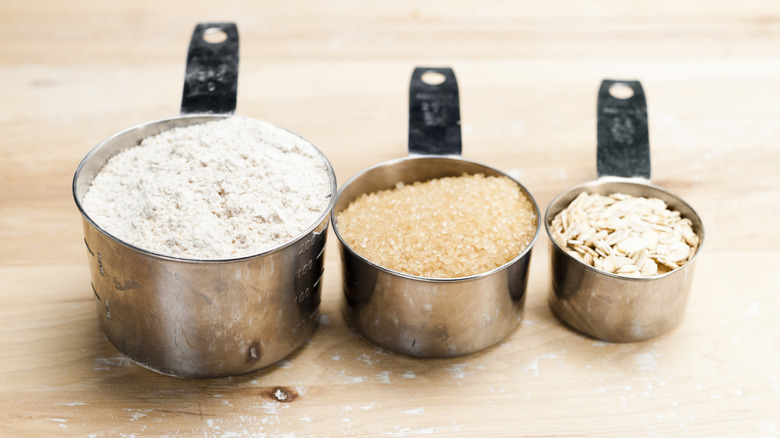Your Measuring Cups Are Sabotaging Your Recipes, According To Alton Brown
We may receive a commission on purchases made from links.
While some recipes can be measured with your heart, many baked goods can turn into a disaster if the ingredients aren't measured out properly — and this disaster can look like your cookies spreading too much, an overly dry cake, or flat, dense muffins. But, if you're someone who knows how to measure both wet and dry ingredients, yet you're still having these problems, Alton Brown says it's because you're not measuring by weight.
In his book, "I'm Just Here for the Food," Brown mentions that measuring by volume leads to inconsistent results. "Heck, I've seen a cup of flour weigh anywhere from 3 to 6 ounces," Brown complains. "If you want to measure flour, you have to do so by weight. End of story." (A cup should weigh 8 ounces, for those keeping track.)
Fluffing your flour, packing it into the cup, or not leveling it out are all factors that can leave you with enough of a weight difference to alter the final result in your baked goods. And it's not just flour — the same goes for other ingredients like brown sugar, which can easily be compressed. So, if you're going for accuracy, using a kitchen scale is your best bet, since the numbers won't lie.
How to measure by volume correctly
For those who don't own a kitchen scale or have yet to replace the batteries, there are still a few ways to make measuring by volume as accurate as possible. If you're using a measuring cup to measure dry ingredients like flour, sugar, or cocoa powder, the best tactic is to spoon them into the cup, rather than dipping the cup directly into the bag for a scoop. The second method might be quicker, but you risk getting more than you need if the ingredient becomes tightly packed. When spooning, you can overfill the cup slightly, before leveling it out with a knife — and remember, never press the knife down into the cup. If your dry ingredient needs to be sifted, make sure to weigh it beforehand, since sifting will make it much lighter.
While there's less chance of error when measuring liquid ingredients by volume, there are a few things to keep in mind. Make sure your measuring cup is on a flat surface, and you are at eye level with it before reading the measurement lines. It's also better to use the smallest cup possible for the quantity you need so that it's easier to get an accurate reading. (Steer clear of the inaccurate TikTok hack for measuring wet ingredients, since you might end up with a baking disaster — and we're all about keeping those to a minimum.)

